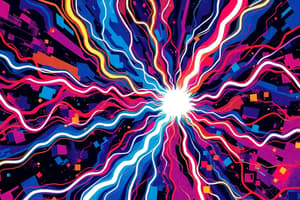Podcast
Questions and Answers
What is at the heart of electricity?
What is at the heart of electricity?
- Voltage difference
- Power generation
- Magnetic forces
- Charged particles (correct)
Who discovered the relationship between electricity and magnetic forces?
Who discovered the relationship between electricity and magnetic forces?
- Hans Christian Oersted (correct)
- Thomas Edison
- James Clerk Maxwell
- Nikola Tesla
What does Faraday's Law relate to?
What does Faraday's Law relate to?
- Voltage regulation
- Magnetic resistance
- Electromagnetic induction (correct)
- Power consumption
What drives the flow of charged particles in electric current?
What drives the flow of charged particles in electric current?
What property does Ohm's Law relate voltage, current, and resistance to?
What property does Ohm's Law relate voltage, current, and resistance to?
In electromagnetism, what happens when a changing magnetic field interacts with a conductor?
In electromagnetism, what happens when a changing magnetic field interacts with a conductor?
What is the unit of electric power?
What is the unit of electric power?
In generators, what creates an alternating current (AC) through induced voltages in coils?
In generators, what creates an alternating current (AC) through induced voltages in coils?
How does resistance affect current flow according to Ohm's Law?
How does resistance affect current flow according to Ohm's Law?
What do Kirchhoff's laws describe in circuit analysis?
What do Kirchhoff's laws describe in circuit analysis?
What does higher power consumption indicate in devices?
What does higher power consumption indicate in devices?
How do voltage sources like batteries contribute to circuits?
How do voltage sources like batteries contribute to circuits?
Flashcards are hidden until you start studying
Study Notes
Electricity: A Foundational Guide to Charged Particles, Magnetic Forces, Power, and Circuits
Electricity is a fundamental part of our daily lives—from lighting up homes to driving advanced technologies. To grasp this fascinating phenomenon, we delve into its core concepts starting with electric current, then exploring how electricity intertwines with magnetism through Faraday’s Law, understanding why power matters, and finally learning about Ohm’s law and circuit behavior.
Electric Current
At the heart of electricity lies electric current, which consists of charged particles—most commonly, negatively charged electrons—flowing along conductive materials like copper wires. These charges move from areas of higher electrical potential to lower ones, driven by a difference in voltage across two points within a closed loop. This flow of charge creates a continuous stream of energy, enabling various applications such as light bulbs glowing or a TV screen displaying images.
Electromagnetism
The relationship between electricity and magnetic forces forms the basis of electromagnetism, discovered by Hans Christian Oersted and James Clerk Maxwell. When an electric current flows through a wire, it generates a magnetic field around itself. Conversely, when a changing magnetic field passes near a conductor, it induces an electric potential and current through what is known as Faraday's Law or electromagnetic induction. One key example of this principle can be seen in generators—their rotating magnets create an alternating current (AC) via induced voltages in coils.
Electric Power
Power measures the rate of energy transfer and consumption, often expressed in units of watts (W). Higher power levels mean more work performed per unit time; hence, they indicate increased effectiveness in devices. For instance, a laptop may consume less than 100 W while a hair dryer might require several hundred watts, depending upon their respective functionalities. Understanding power helps us determine optimal device performance, energy efficiency, and conservation efforts.
Ohm's Law
Ohm's Law describes the direct proportionality between applied voltage (V) and resulting current (I) through a resistor, given temperature constancy. Resistance (R) determines how much voltage is needed to produce a specific amount of current. As resistance increases, the required voltage grows proportionally, thereby decreasing current. Knowledge of Ohm's Law enables engineers to design efficient electronic systems, predict equipment outcomes, and understand component limitations.
Circuit Basics
Circuit analysis involves analyzing interactions among circuits' components, including batteries, resistors, capacitors, and switches. Voltage sources (like batteries) drive current through connected elements. By applying Kirchhoff's laws—which describe principles related to voltage and current relationships in closed loops—we can solve complex circuit problems and better comprehend the inner workings of electricity distribution networks.
To reiterate, these foundations will guide you towards deeper insights into electricity's intricate dynamics and allow you to appreciate this remarkable force shaping modern society. Whether you're curious learner or aspiring engineer, familiarizing yourself with these concepts paves the path toward mastery in a realm where endless innovation awaits!
Studying That Suits You
Use AI to generate personalized quizzes and flashcards to suit your learning preferences.




